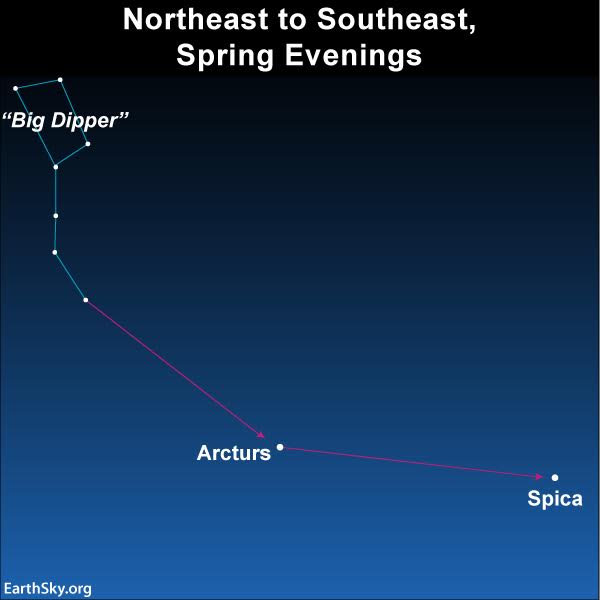
At nightfall tonight, or any June evening, look in a general southward direction for Spica, the brightest star in the constellation Virgo the Maiden. If you live in the Southern Hemisphere, Spica appears overhead or high in your northern sky around 9 p.m. in early June. Spica is your jumping off point to three faint constellations: Corvus the Crow, Crater the Cup and Hydra the Snake.
If you’re familiar with the Big Dipper, use this signpost star formation to star-hop to Spica, as shown in the sky chart below:

Use the Big Dipper to arc to Arcturus and spike Spica. Read more.
You can use Spica to find the constellation Corvus – and alternately, use Corvus to confirm that you’ve found Spica:

Here’s another way to verify that you’re looking at Spica, the brightest star in the constellation Virgo.
Okay … got Spica? Now, as nightfall deepens into later evening, watch for a number of fainter stars to become visible. That’s when the Crow, the Cup and the Water Snake will come into view.
Sky chart of the constellation Hydra, including Corvus and the Crater via IAU.
In Greek mythology, Apollo sent the crow to fetch a cup of water. The crow, Corvus, got distracted eating figs. It was only after much delay that he finally remembered his mission. Rightly figuring that Apollo would be angry, the crow plucked a snake from the water and concocted a story about how it had attacked and delayed him.
Hydra the Water Snake with the orange star Alphard at its heart. Illustration via Deanspace.
Apollo was not fooled and angrily flung the Crow, Cup and Snake into the sky, placing the Crow and Cup on the Snake’s back.
Then the god ordered Hydra to never let the Crow drink from the Cup. As a further punishment, he ordered that the Crow could never sing again, only screech and caw.
None of these constellations has any bright stars, but Hydra holds the distinction of being the longest constellation in the heavens.
Bottom line: Use the bright star Spica to help you find the constellations Corvus the Crow, Crater the Cup, and Hydra the Water Snake.
Enjoying EarthSky so far? Sign up for our free daily newsletter today!
from EarthSky http://bit.ly/2QEOhXH

At nightfall tonight, or any June evening, look in a general southward direction for Spica, the brightest star in the constellation Virgo the Maiden. If you live in the Southern Hemisphere, Spica appears overhead or high in your northern sky around 9 p.m. in early June. Spica is your jumping off point to three faint constellations: Corvus the Crow, Crater the Cup and Hydra the Snake.
If you’re familiar with the Big Dipper, use this signpost star formation to star-hop to Spica, as shown in the sky chart below:

Use the Big Dipper to arc to Arcturus and spike Spica. Read more.
You can use Spica to find the constellation Corvus – and alternately, use Corvus to confirm that you’ve found Spica:

Here’s another way to verify that you’re looking at Spica, the brightest star in the constellation Virgo.
Okay … got Spica? Now, as nightfall deepens into later evening, watch for a number of fainter stars to become visible. That’s when the Crow, the Cup and the Water Snake will come into view.
Sky chart of the constellation Hydra, including Corvus and the Crater via IAU.
In Greek mythology, Apollo sent the crow to fetch a cup of water. The crow, Corvus, got distracted eating figs. It was only after much delay that he finally remembered his mission. Rightly figuring that Apollo would be angry, the crow plucked a snake from the water and concocted a story about how it had attacked and delayed him.
Hydra the Water Snake with the orange star Alphard at its heart. Illustration via Deanspace.
Apollo was not fooled and angrily flung the Crow, Cup and Snake into the sky, placing the Crow and Cup on the Snake’s back.
Then the god ordered Hydra to never let the Crow drink from the Cup. As a further punishment, he ordered that the Crow could never sing again, only screech and caw.
None of these constellations has any bright stars, but Hydra holds the distinction of being the longest constellation in the heavens.
Bottom line: Use the bright star Spica to help you find the constellations Corvus the Crow, Crater the Cup, and Hydra the Water Snake.
Enjoying EarthSky so far? Sign up for our free daily newsletter today!
from EarthSky http://bit.ly/2QEOhXH

Aucun commentaire:
Enregistrer un commentaire